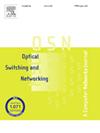可生存弹性光网络:故障场景和解决方案的综述
IF 3.1
4区 计算机科学
Q3 COMPUTER SCIENCE, INFORMATION SYSTEMS
引用次数: 0
摘要
可生存弹性光网络(SEON)是高速、灵活和带宽高效光通信的前沿。现代柔性网格弹性光网络(EON)通过分配变宽频率槽来适应异构业务需求和调制格式;这里讨论的生存性机制在频谱槽层工作,与底层应答器波形无关。尽管有这些优势,但确保在各种故障(包括单链路、多链路、节点和硬件中断)下的生存能力仍然是一个主要挑战。本文对SEON的生存能力进行了全面的研究,特别强调了根据不同的故障情况对解决方案进行分类。系统地分析和比较了专用路径保护、共享备份路径保护、分段和跨度恢复、p周期保护等最新策略。与之前的调查不同,这项工作将分类框架与性能见解相结合,突出了现有机制在不同类型故障下的表现。为了弥合现有的差距,我们还讨论了开放的研究挑战,包括集中控制、频谱管理、人工智能驱动的弹性、物理层损伤和灾难恢复。此外,我们概述了结合状态感知流量分割、动态分配和漏洞评分的混合保护范式的潜力,以提高频谱利用率并降低阻塞概率。通过将故障场景与恢复策略和未来研究需求联系起来,本研究为指导可扩展、自适应和智能SEON架构的设计提供了独特的视角。本文章由计算机程序翻译,如有差异,请以英文原文为准。
Survivable Elastic Optical Network: A survey of failure scenarios and solutions
Survivable Elastic Optical Networks (SEON) are at the forefront of high-speed, flexible, and bandwidth-efficient optical communication. Modern flex-grid Elastic Optical Networks (EON) allocate variable-width frequency slots to match heterogeneous traffic demands and modulation formats; the survivability mechanisms discussed here operate at the spectrum slot layer and are agnostic to the underlying transponder waveform. Despite these advantages, ensuring survivability against diverse failures, including single-link, multi-link, node and hardware outages, remains a major challenge. This paper presents a comprehensive survey of SEON survivability, with a particular emphasis on classifying solutions according to different failure scenarios. State-of-the-art strategies such as Dedicated Path Protection, Shared Backup Path Protection, segmented and span restoration, and p-cycle protection are systematically analyzed and compared. Unlike previous surveys, this work integrates a classification framework with performance insights, highlighting how existing mechanisms fare under different types of failures. To bridge existing gaps, we also discuss open research challenges, including centralized control, spectrum management, AI-driven resilience, physical layer impairments and disaster recovery. Furthermore, we outline the potential of a hybrid protection paradigm combining state-aware traffic splitting, dynamic allocation, and vulnerability scoring to improve spectrum utilization and reduce blocking probability. By linking failure scenarios with recovery strategies and future research needs, this survey provides a unique perspective to guide the design of scalable, adaptive and intelligent SEON architectures.
求助全文
通过发布文献求助,成功后即可免费获取论文全文。
去求助
来源期刊

Optical Switching and Networking
COMPUTER SCIENCE, INFORMATION SYSTEMS-OPTICS
CiteScore
5.20
自引率
18.20%
发文量
29
审稿时长
77 days
期刊介绍:
Optical Switching and Networking (OSN) is an archival journal aiming to provide complete coverage of all topics of interest to those involved in the optical and high-speed opto-electronic networking areas. The editorial board is committed to providing detailed, constructive feedback to submitted papers, as well as a fast turn-around time.
Optical Switching and Networking considers high-quality, original, and unpublished contributions addressing all aspects of optical and opto-electronic networks. Specific areas of interest include, but are not limited to:
• Optical and Opto-Electronic Backbone, Metropolitan and Local Area Networks
• Optical Data Center Networks
• Elastic optical networks
• Green Optical Networks
• Software Defined Optical Networks
• Novel Multi-layer Architectures and Protocols (Ethernet, Internet, Physical Layer)
• Optical Networks for Interet of Things (IOT)
• Home Networks, In-Vehicle Networks, and Other Short-Reach Networks
• Optical Access Networks
• Optical Data Center Interconnection Systems
• Optical OFDM and coherent optical network systems
• Free Space Optics (FSO) networks
• Hybrid Fiber - Wireless Networks
• Optical Satellite Networks
• Visible Light Communication Networks
• Optical Storage Networks
• Optical Network Security
• Optical Network Resiliance and Reliability
• Control Plane Issues and Signaling Protocols
• Optical Quality of Service (OQoS) and Impairment Monitoring
• Optical Layer Anycast, Broadcast and Multicast
• Optical Network Applications, Testbeds and Experimental Networks
• Optical Network for Science and High Performance Computing Networks
 求助内容:
求助内容: 应助结果提醒方式:
应助结果提醒方式:


